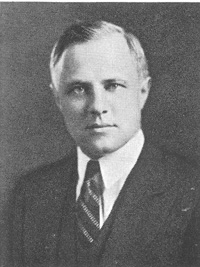It’s true we Americans don’t know very much about you Japanese, and never did. And now I realise you know even less about us. You can kill us, all of us, or part of us, but if you think that will put fear into the United States of America and stop them from sending other flyers to bomb you, you’re wrong, dead wrong. They’ll come by night and by day, thousands of them. They’ll blacken your skies and burn your cities and make you beg for mercy. This is your war. You wanted it. You asked for it. You started it. Now you’re going to get it. And it won’t be finished until your dirty little empire is wiped off the face of the earth.
Dana Andrews as Captain Harvey Ross, speech before sentence, Purple Heart (1944)
Released on March 8, 1944, the film The Purple Heart (1944) is a dramatization of the show trial the Japanese held of the captured Doolittle raiders. Eight of the raiders were captured. Of the captured raiders, three were executed by the Japanese on October 15, 1942 following the show trial. They were the first of approximately 132 American airmen executed after capture by the Japanese government. Contrary to the film, the details were not released by the Japanese, the three condemned raiders were not tried in a civilian court but by a drumhead courtmartial consisting of Japanese officers. The men executed were First Lieutenant William G. Farrow, Sergeant Harold A. Spatz and First Lieutenant Dean E. Hallmark.
The remaining five POWs were placed on starvation rations, with one of them dying prior to liberation by the Allied forces at the end of the War. Jacob DeShazer, one of the POWs, came back to Japan as a missionary in 1948 and worked there for 30 years spreading the Gospel.
The film is strangely prophetic in regard to the bombing campaign that would bring the Japanese Empire to its knees. Until 1945 the bombing campaign against Japan had been ineffective, due to lack of air bases close to Japan and the scattered nature of Japanese industry in Japanese cities throughout residential areas. Precision daylight bombing as performed by the US Army Air Corps in the European Theater was useless under those conditions. After General Curtis E. Lemay was appointed commander of the XX Bomber Command in the Marianas in January 1945 that all changed. Lemay hit upon the idea of stripping all superfluous equipment, including machine guns, off his B-29s, packing them with incendiary bombs, topping off the gas tanks in midair after take off, and having them fly so high that the Japanese could not intercept them, He then conducted massive incendiary raids on Japanese cities which, by the end of war, killed around half a million Japanese civilians and left five million homeless. Some 40% of Japanese urban areas in 66 cities went up in flames, along with most Japanese war industry. Lemay intended to destroy every Japanese urban center, and he would have if the War had not ended swiftly after the atomic bombings of Hiroshima, August 6, 1945, and Nagasaki, August 9, 1945.
“Don’t let this get you down. Just remember God will make everything right and that I’ll see you all again in the hereafter. . . . Read “Thanatopsis” by Bryant if you want to know how I am taking this. My faith in God is complete, so I am unafraid.”
From a letter by First Lieutenant William G. Farrow to his mother.

